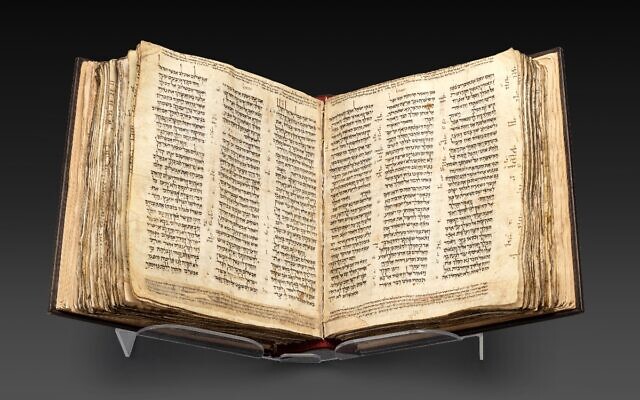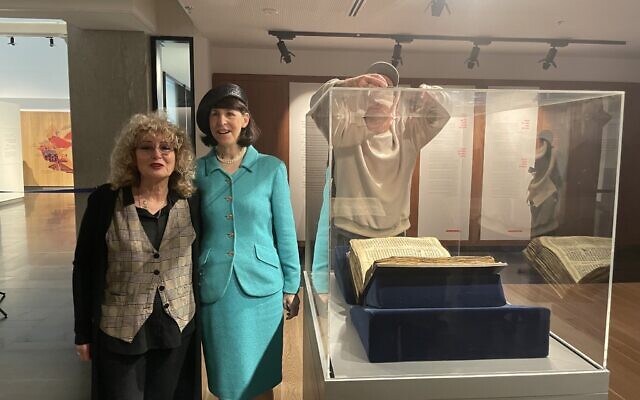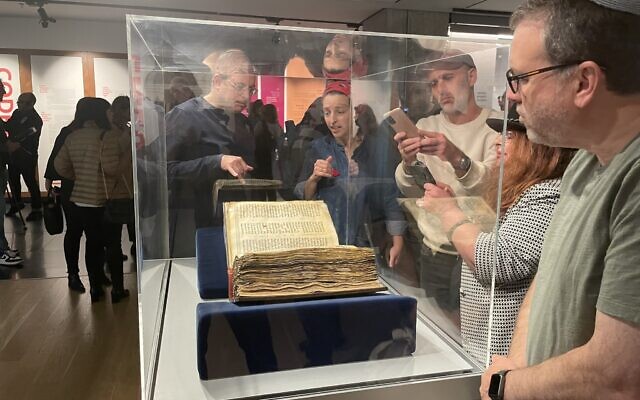Oldest & Most Complete Hebrew Bible Manuscript on Display in Israel for 1st Time
The Codex Sassoon, valued at $30-$50 million, can be viewed for free at Tel Aviv’s Anu Museum ahead of its Sotheby’s New York sale.

The Codex Sassoon, the oldest-known and the most complete Hebrew Bible manuscript, will go on display for the first time in Israel on Thursday at Tel Aviv’s Anu Museum, giving the public a rare opportunity to see the book before it is auctioned at Sotheby’s New York for an expected $30-$50 million.
The Masoretic codex comprises all 24 books of the Hebrew Bible and dates to the 10th century CE. The March 23-29 viewing at Anu will be free with pre-registration at the museum website.
“These are complicated days in Israel,” said Irina Nevzlin, chair of Anu’s board of directors, referring to the ongoing political turmoil. “Everything seems unclear and unsure, and it feels right to touch something that tells the story of our nation and allows the ability to look back into the past and forward towards the future. The Codex tells the stories of hundreds of years as Israel marks 75 years.”

(Nevzlin is married to Likud Knesset member Yuli Edelstein. Nevzlin’s father, Leonid Nevzlin, a Russian billionaire, gave $30 million to the museum’s recent $100 million renovation.)
The Bible, all 792 pages of it, about six inches thick and opened to its middle, sits in a glass vitrine in the museum’s permanent exhibition area, surrounded by other ancient and newer manuscripts of the Bible.
“We debated where to show it,” said Orit Shaham Gover, Anu’s chief curator. “The lobby would’ve been easy, or an empty gallery. We chose to put it into the permanent exhibit. We created a space for it in the foundations gallery, showing the Bible and its effect on the world.”
What’s unique about the Sassoon Codex is that this ancient manuscript can be opened and read, and is absolutely accessible, said Sharon Mintz, Sotheby’s senior Judaica specialist, books and manuscripts, who accompanied the manuscript to Israel.

Written circa the year 900, it includes vowels and cantillation marks that indicate how to read it properly.
It’s the first example of a completely stable and accurate text, said Mintz.
It was also very expensive to produce, written in the hand of one scribe, probably over the course of a year or two, said Mintz, in a “laborious process.”
The manuscript was written on sheepskin parchment, and “would have required about 200 sheepskins to produce,” she said. “Only the wealthiest of individuals could have afforded to commission this.”
The manuscript changed hands multiple times. One deed of sale is written into the middle of the volume in Judeo-Arabic, around 100 years after it was penned, with signatures of the scribe and a witness. It was probably written on the middle page in order to ensure that the information would not get lost, as first and last pages of books can get torn or misplaced, said Mintz.
The book landed at one point in the 13th century at a Syrian synagogue before reemerging when collector David Solomon Sassoon purchased it for £350 in 1929.
His descendants sold it in 1978 to the British Rail Pension Fund through Sotheby’s Zurich and the Sassoon Codex was exhibited in 1982 at the British Museum before it was auctioned again through Sotheby’s in 1989, when it was sold to a dealer for £2,035,000, who sold it to collector Jacqui Safra that same year.
Bar Ilan University Bible professor Yosef Ofer first viewed the Codex at Safra’s home in Geneva a few years ago and is currently working on a critical work about the ancient manuscript.
“I spent four days with it in one room,” said Ofer, “with guards situated outside.”
The Codex is considered as old as the Aleppo Codex, known as Keter Aram Soba, also written around the 10th century CE, and is a century older than the Leningrad Codex.
“It’s not like today, when a new soldier gets a Bible that costs NIS 10 to print,” said Ofer. “They were very valuable, the holdings of wealthy communities that could allow themselves to hire a scribe to write such a manuscript.”
The Bible consists of 24 books divided into three parts, the Pentateuch, the Prophets and the Writings. Each page is divided into three columns.
The display is sponsored by Mifal Hapayis, Israel’s national lottery, which supports various cultural and educational ventures.
- Israel news
- Community
- Codex Sassoon
- Hebrew Bible
- Anu Museum
- Sotheby’s New York
- Masoretic codex
- Irina Nevzlin
- Likud Knesset
- Yuli Edelstein
- Orit Shaham Gover
- Sharon Mintz
- judaica
- David Solomon Sassoon
- British Rail Pension Fund
- British Museum
- Jacqui Safra
- Bar-Ilan University
- Bible professor Yosef Ofer f
- Aleppo Codex
- Keter Aram Soba
- Mifal Hapayis



comments